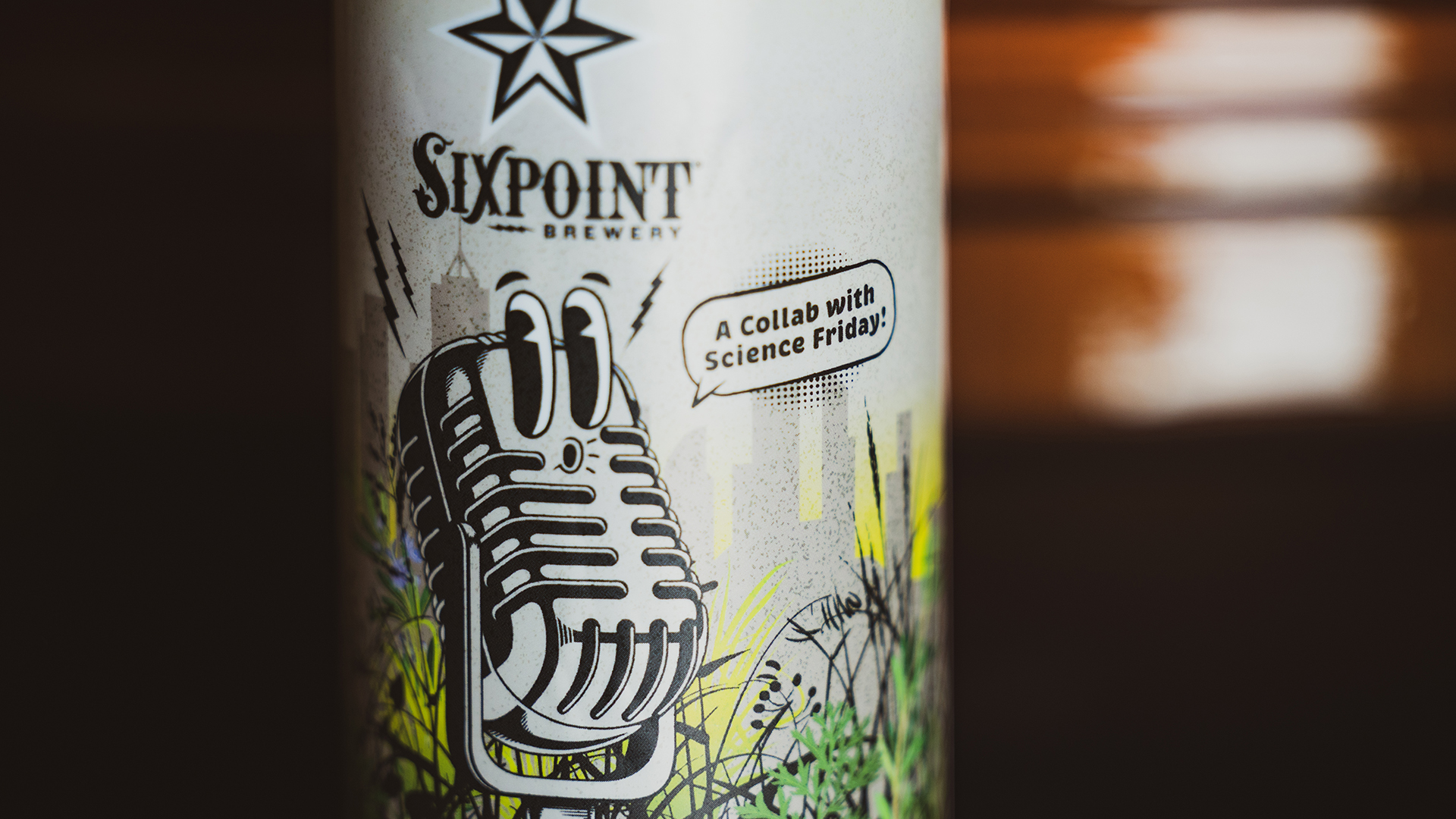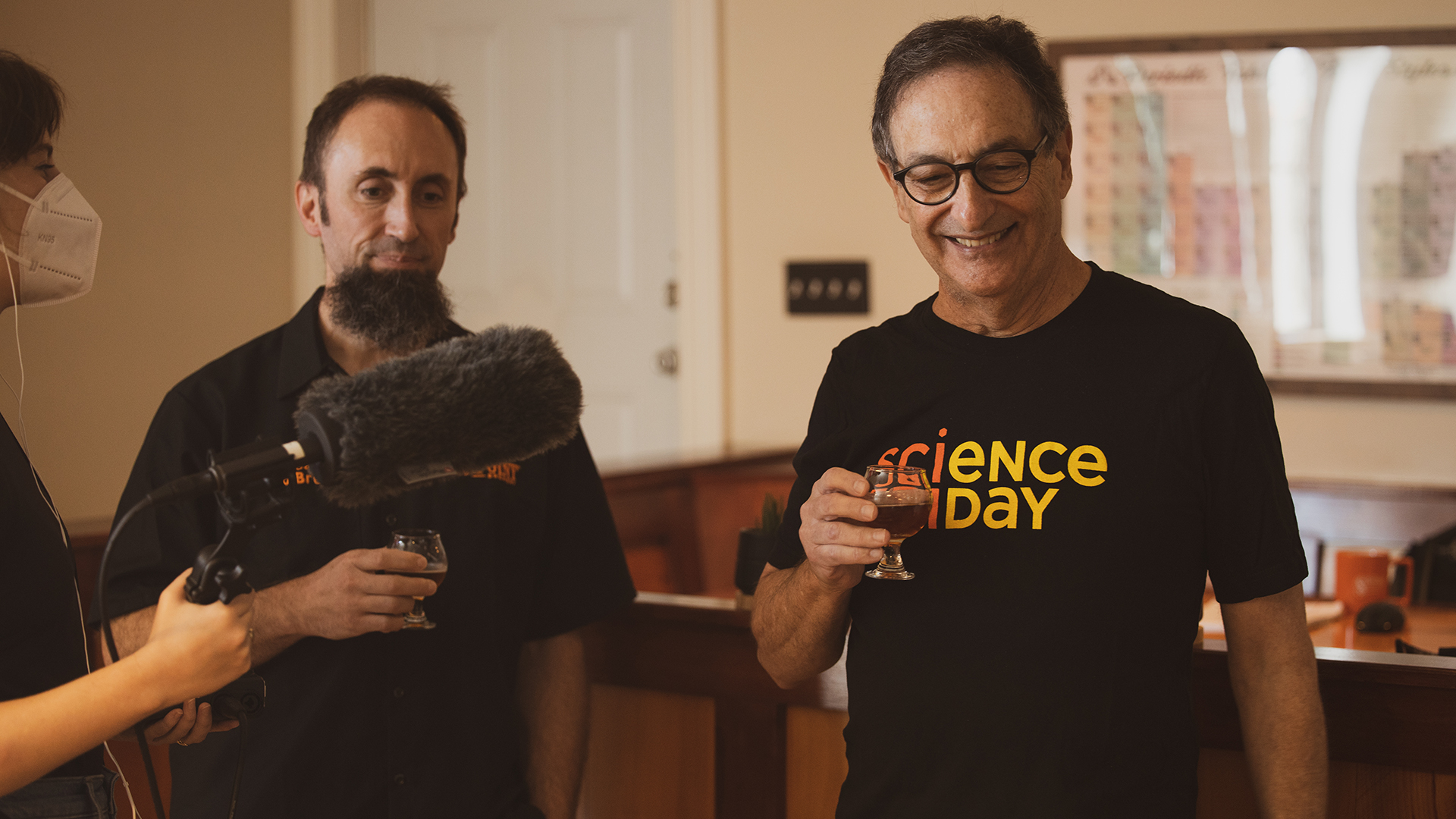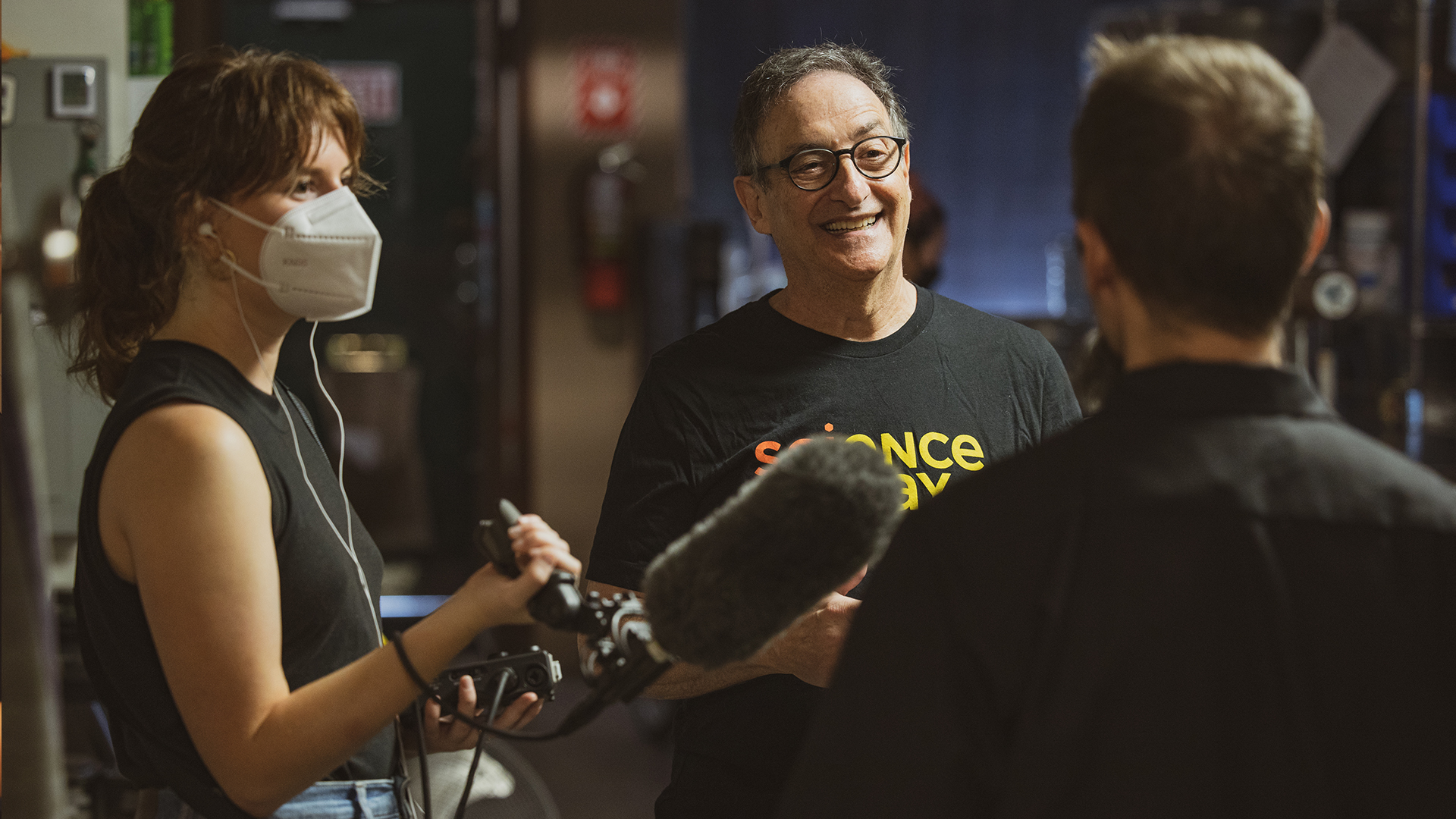A Taste Of New York In A Hyper-Local Beer
16:21 minutes

 If you’re a person who enjoys beer, you’ve likely been aware of the craft beer boom of the last couple of decades. India Pale Ales, or IPAs, have become some of the most popular types of beer brewed in local breweries. But it doesn’t get more local than a type of beer that most people have never heard of: the gruit.
If you’re a person who enjoys beer, you’ve likely been aware of the craft beer boom of the last couple of decades. India Pale Ales, or IPAs, have become some of the most popular types of beer brewed in local breweries. But it doesn’t get more local than a type of beer that most people have never heard of: the gruit.
The gruit traces its origins back to the 11th century. Historically, instead of hops, brewers used herbs and spices native to wherever they lived. This results in a flavorful beer that changes taste depending on the plant life in the region.
Fast forward a few hundred years to now, and you’ll find brewers getting back to this hyper-local brewing tradition. Those brewers include Isaac Patient, head brewer of Sixpoint Brewery in Brooklyn, New York. His team partnered with Saara Nafici and Brendan Parker at Red Hook Farms to procure four key herbs for the brew: rosemary, tarragon, lemongrass, and mugwort.

The two Red Hook establishments also partnered with Science Friday to bring this medieval, hyper-local beer to local listeners. They’re calling the result “A Field Story,” and it’s an herbal, flavorful beer unlike anything Ira Flatow and guest host Kathleen Davis have tasted.
To find where “A Field Story” is being sold in Brooklyn, NY, click here.

Invest in quality science journalism by making a donation to Science Friday.
Brendan Parker is the farm manager at the Red Hook Initiative in Brooklyn, New York.
Saara Nafici is the director of Red Hook Farms in Brooklyn, New York.
Isaac Patient is the head brewer at the Sixpoint Brewery in Brooklyn, New York.
KATHLEEN DAVIS: This is Science Friday. I’m Kathleen Davis.
IRA FLATOW: And I’m Ira Flatow. If you’re a person who, like me, enjoys beer, you’ve likely been aware of the craft beer boom of the last couple of decades, right? Like your India Pale Ales or your IPAs. They have become the most popular type of craft beer brewed in your local neighborhood. But I’ll bet it doesn’t get more local than a type of beer you probably haven’t heard of– the gruit.
KATHLEEN DAVIS: This beer traces its origins back to the 11th century. Yeah. And historically, instead of hops, it used herbs and spices native to wherever it was made. This results in a flavorful beer that changes taste depending on the brewer.
IRA FLATOW: Now, fast forward a few hundred years, to now, and you find brewers trying to get back to this hyper-local brewing tradition. So we’re going to take you on a journey to Brooklyn, New York, where a community farm and local brewery came together with a radio show– yes, that’s us– to make a gruit.
The hope is that the community will get to enjoy this beer made with ingredients grown right in the neighborhood. I got the fun assignment. I got to go to the brewery.
KATHLEEN DAVIS: And I got to go to the farm right at the start of fall.
Fall is a beautiful time in New York. The leaves are starting to change, the air is crisp, and people– myself included– are pulling out their favorite sweaters. Fall also means it’s harvest season for farmers like Brendan Parker.
BRENDAN PARKER: So welcome to Red Hook Farms, the Columbia Street farm. We’re a 2.75-acre youth center urban farm in Red Hook, Brooklyn. We operate this farm on New York City Parks Department land. And we grow an intensely diverse range of crops, with youth at the center.
KATHLEEN DAVIS: Brendan is the senior farm manager here. He works with local kids to grow a whole bunch of things, from collard greens to root vegetables. On site, there’s also a beehive and chickens. The farm grows more than 15,000 pounds of produce each year, most of which goes right back into the community.
Red Hook Farms feels like an oasis in Brooklyn’s Red Hook neighborhood. The area is industrial. And you can see a whole bunch of warehouses right from the farm. That includes three Amazon facilities and an IKEA.
There’s a long history of processing and manufacturing in Red Hook, which has left it with a contaminated legacy.
BRENDAN PARKER: So the history of this site– it was operated as a large baseball and tennis field that was entirely on asphalt. And we put soil directly on top of the asphalt. Because Red Hook is a community that is dealing with a lot of soil contamination, there’s a legacy of processing lead in Red Hook. And I think we’ve proven that it’s a huge opportunity. You can take an asphalt lot, turn it into a vibrant urban farm that hosts youth and community members and all of this wildlife within it.
When you step into the farm, it really doesn’t feel like you are directly on top of the asphalt, which we are.
KATHLEEN DAVIS: Red Hook is geographically separated from the rest of Brooklyn. Saara Nafici, director of Red Hook Farms, says that’s contributed to a history of disinvestment in this area. She says that’s why it’s so important that Red Hook Farms exists– to be a green pocket in this industrial, underserved area.
SAARA NAFICI: And then you can see floating around us are monarch butterflies. We are still part of a larger ecosystem. That migration is happening. They are stopping here. They are drinking nectar from the flowers we have planted for them. And hopefully they’ll make it all the way to Mexico, or their next generation will.
KATHLEEN DAVIS: Red Hook Farms champions its local produce, from those big leafy greens to the small herbs. So when a local brewery reached out, asking if they’d like to help make a gruit, it seemed like a great fit.
IRA FLATOW: Yeah, that takes us– me– to the brewery. Sixpoint is a block away from the farm. While Sixpoint has a big focus on IPAs, this location is focused on innovation brews, drinks that are sometimes off the beaten path. The day I came to visit, they were brewing the gruit, made from the ingredients grown at Red Hook Farms.
Head Brewer Isaac Patient is a big fan of gruit-style brews, which have a long history, dating back to Western Europe in the 11th century.
ISAAC PATIENT: It contained hops, but it was more like a spice sachet that was originally picked out by a gruit maker. And it was to balance the maltiness of the beer. So there was some bittering things he would add, like lavender. A stem of lavender is almost just as bitter. If you just add that like you were going to add in an IPA, that’s going to make it just as bitter, but it’s going to have a more floral flavor than hops would.
IRA FLATOW: For a beer to go to market here in the US, it legally has to have some hops. But what sets gruit apart from the other beers is that these herbs and spices are the star of the show. How does that impact the flavor, you may ask.
ISAAC PATIENT: So it’s a little bit more herbal. Obviously, you’re going to have a lot more flavors in there. And they’re more geared towards a medieval pairing to match food.
IRA FLATOW: I like that.
ISAAC PATIENT: Yeah.
IRA FLATOW: Are there lots of kinds of gruits?
ISAAC PATIENT: Yeah. So that is a little bit interesting because there is a traditional gruit that has very specific herbs in it– yarrow, rosemary. They were sort of like the foundation, but brewers were using all sorts of herbs and spices that they could find in their area. There is even like wormwood that you can use. But some of those are a little bit controversial because there’s certain psychotropic things that go along with them. So they’re not usually included in today’s gruit.
IRA FLATOW: I’ve got to admit it– I have never heard of gruit before I went to the brewery, even though it’s an old-style beer with a ton of history. And I’m not alone.
ISAAC PATIENT: A lot of those styles during Prohibition fell way down off the radar and have taken a while to kind of peek back up.
IRA FLATOW: Isaac learned about this medieval-style beer from a legendary gruit at brewer in New Hampshire, named Butch Heilshorn.
ISAAC PATIENT: And he would hire foragers to just go out and pick whatever they could. And then they’d bring it back. And he would just pick random things and then make a beer out of those things. So when this opportunity came up, we started talking about, what herbs can we get the Red Hook Initiative Farm to grow? And how can we make that into a beer? And it’s been an awesome experience to be able to do it on such a large scale.
IRA FLATOW: The Sixpoint gruit has four key herbs– rosemary, tarragon, lemongrass, and mugwort. All of these were grown at the Red Hook Farms.
KATHLEEN DAVIS: Back at the farm, director Saara Nafici explained what makes these herbs so special.
SAARA NAFICI: We have rosemary. Probably the most familiar for American cooking. We have rosemary. It’s in the Salvia family or the mint family, so it has that square stem. Most things in the mint family are very pungent, fragrant, medicinal, flavorful.
KATHLEEN DAVIS: It’s commonly used in meat flavorings. It’s not something that people typically drink.
SAARA NAFICI: And then rosemary has the deep literary tradition– Shakespeare– everyone’s writing about rosemary. And it is not from England, but it was brought there and became very– it seems very core to English cuisine and English things. But like most things that are core to English cuisine and tradition and culture, it is not actually from the island of England.
KATHLEEN DAVIS: Tarragon is another culinary herb. Like rosemary, it has long thin leaves. But the flavor is a little more similar to anise.
SAARA NAFICI: My family is Iranian. We eat this raw with food. We put this in– it’s one of the main flavors of stuffed grape leaves. It’s also a bitter, though. So all of these different herbs that we’ve collected are mostly on the bitter side, to provide flavoring. And it’s such a unique smell that you really don’t smell in other typical culinary herbs.
KATHLEEN DAVIS: Lemongrass may be the most pungent of the four herbs.
SAARA NAFICI: Lemongrass is one of the power flavors. You barely have to rip it and smell it, and you get that citrus. This is in the grass family. Completely different part of the world. This is from– there’s different varieties all across Asia, South Asia, East Asia, Southeast Asia, and mostly used medicinally, as a flavoring, as an aromatic. This one is a beautiful variety. It has this burgundy stem. It grows out to be about 2-3 feet long, very dramatic, beautiful looking, and a very common flavor for a lot of East Asian and South Asian cooking.
KATHLEEN DAVIS: And finally, mugwort, which Saara calls the star of the gruit. Historically, mugwort is a central ingredient of the beverage.
SAARA NAFICI: It’s really good at being a plant. It’s really good at being a weedy plant. Doesn’t need a lot of love. Doesn’t need a lot of attention. It’ll grow on the roadside. It’ll grow in the subway crack. And when I see it on the farm, I have a little heart palpitation because it spreads so aggressively by these amazing underground rhizomes. Which I can dig up and show you.
KATHLEEN DAVIS: Saara pulls the mugwort out of the ground, revealing long stems that were hidden below the soil.
SAARA NAFICI: So you see these long– these are underground stems, called rhizomes. And they’ll break off, as I pull this out, and re-sprout. It’ll also spread and effectively colonize a whole area, which makes it such a really strong, powerful plant. And then, if you flip it over, you have this beautiful underside that’s white. And that can help you distinguish it from chrysanthemums or other things. But if you crush it and you smell it, you get that kind of anise-y scent. And then, if you taste it, it’s the bitter, right?
KATHLEEN DAVIS: Mugwort is related to wormwood. That’s the herb that’s used to make absinthe. This family of plants, which is called Artemisia, has psychotropic qualities. Some people say mugwort gives them lucid dreams. But those effects disappear once the plant is cooked and processed. So don’t expect to grow it to get you trippy.
If it sounds like Saara is the president of the mugwort fan club, it’s because she might as well be. She has a mugwort plant tattooed on her upper arm, complete with ladybug larvae.
SAARA NAFICI: I also love it because, if you catch it at the right time– so like early summer, late spring– it’s an entire universe. It’s an entire universe of ladybugs at all different levels of development. You have the larva, you have the eggs, you have the adults, and just hundreds of them on a single one that’s growing in between an auto body shop garage door and the pavement. And I can’t help but see the wonder and amazement of this plant that doesn’t need anything. It’s in the crack of a sidewalk, but providing an entire ecosystem to so many different animals.
KATHLEEN DAVIS: It’s also a personal plant for Saara.
SAARA NAFICI: As a child of immigrants to this land that was not always welcoming to people like me, and still is not always welcoming to people like me, and finding a foothold in this country, and seeing if I can also play a role that’s positive, that supports the ecosystem, supports that I have a place here– mugwort has a place here.
And not to anthropomorphize a plant, but I identify with this plant for a reason. It was brought here, and it made its way, and it’s growing in the asphalt and the concrete. And it’s beautiful. And it has a story. It has a long story. We all do. So I love it.
IRA FLATOW: Just a quick note– that I’m Ira Flatow, and this is Science Friday, from WNYC Studios.
Back at the brewery, the mugwort, rosemary, tarragon, and lemongrass are coming together to make the gruit.
ISAAC PATIENT: So we take the grain. Depending on the grains, we crack them. Basically, mill them down. Just barely crack them open. Then we mash in. So we throw all the grain in. We have a very specific temperature of water. That’s going to help activate the specific enzymes that we’re interested in activating.
And then, once that’s done, it sits for about an hour. We move that over into the boil kettle, and we boil it. That’s where we add hops. Or in this case, we’re talking about a gruit today, so we’re going to be adding herbs and spices. And then, once that’s done, we move it into one of these conical fermenters. We add the yeast. It ferments out. When it’s ready, we then carbonate it and send it out.
IRA FLATOW: We headed upstairs for the most important business of the day– tasting the gruit we’ve been following throughout its journey.
ISAAC PATIENT: So the best way to taste a beer is obviously do a short sniff and just recognize the smells and aromas that are coming off of that.
IRA FLATOW: Hmm, it does have an aroma.
ISAAC PATIENT: Yeah. And then what I always tell people to do is to sip and hold it in your mouth, and let it slowly warm up. And once it’s all the way warm, do a slight chewing action– because there are certain olfactories that are not activated until you’re doing that action– and then to swallow. And as you swallow, breathe out through your nose, and you’ll get the full– usually your first sip of a new beer should be that way. That way you get the full experience.
Cheers.
IRA FLATOW: Cheers. Oh, that’s good.
ISAAC PATIENT: Yeah.
IRA FLATOW: It’s really different.
ISAAC PATIENT: Yeah.
IRA FLATOW: That is really different. It feels like it wants to be an IPA, then it changes into something else.
ISAAC PATIENT: Yeah, right. Exactly.
IRA FLATOW: Yeah. Wow. You can really definitely tell there are herbs in there.
ISAAC PATIENT: Right. Yeah.
IRA FLATOW: So will there be a gruit revolution? Well, it’s hard to say. But Isaac says some craft breweries, like Sixpoint, are leaning into more local ingredients to make their beers.
ISAAC PATIENT: You do see a lot more breweries using a little bit more herbs and floral additives. And sometimes it’s not their primary thing, but you might see a beer that’s used dandelion flowers. You might see a beer that’s used some hibiscus in it. So I think that craft brewers have really pushed the boundary of innovation and research and development in beers, and I think that you’ll probably start seeing more and more of it.
IRA FLATOW: So what to call our brew? To come up with the name of the gruit, the staffs of Science Friday, Sixpoint, and Red Hook Farms wanted something that reflected just how local this collaboration was, from the herbs grown on the community land to the story you just heard on the radio.
So we settled on A Field Story. It’s going to be available at stores and at the Sixpoint Taproom in downtown Brooklyn. So if you’re interested in trying it out, you can do so.
KATHLEEN DAVIS: And we’re holding a special launch event for A Field Story for our listeners in the New York City area. If you want to learn more about that, you can do so at sciencefriday.com/beer.
Copyright © 2022 Science Friday Initiative. All rights reserved. Science Friday transcripts are produced on a tight deadline by 3Play Media. Fidelity to the original aired/published audio or video file might vary, and text might be updated or amended in the future. For the authoritative record of Science Friday’s programming, please visit the original aired/published recording. For terms of use and more information, visit our policies pages at http://www.sciencefriday.com/about/policies/.
Kathleen Davis is a producer and fill-in host at Science Friday, which means she spends her weeks researching, writing, editing, and sometimes talking into a microphone. She’s always eager to talk about freshwater lakes and Coney Island diners.
Diana Plasker was the Senior Manager of Experiences at Science Friday, where she created live events, programs and partnerships to delight and engage audiences in the world of science.
Ira Flatow is the founder and host of Science Friday. His green thumb has revived many an office plant at death’s door.